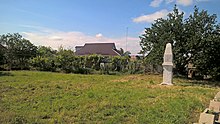Varnița
|
Varnița ( rum. ) Варница ( Russian ) |
||
| State : |
|
|
| Administrative unit : | Anenii Noi Raion | |
| Coordinates : | 46 ° 52 ′ N , 29 ° 28 ′ E | |
| Height : | 84 m. ü. M. | |
| Residents : | 4.210 | |
| Telephone code : | (+373) 265 | |
| Postal code : | MD-6500, MD-6501 | |
| License plate : | ON | |
| Mayor : | Alexandr Nichitenco | |
|
|
||
Varnița ( Russian Варница / Warniza ) is a village with around 4,200 inhabitants in the Republic of Moldova . It is located in the Anenii Noi district , on the Dnestr River and in the south it borders directly on the Transnistrian- controlled city of Bendery .
history
Varnița was first mentioned in 1560. From 1711 to 1713, King Charles XII, who lived in exile at the fortress Bender (town) . (Sweden) the camp of his escort in Varnița. From 1812 to 1917 the village was part of Russia as the Bessarabia Governorate ; from 1917 to 1940 and again from 1941 to 1944 it belonged to Romania . After 1945 all of Moldova was incorporated into the Soviet Union , and with it Varnița. During the Soviet era, the population increased sharply and numerous industrial companies were settled in the region. Varnița grew together with the southern city of Bendery and has been in its suburban belt ever since.
In the course of the collapse of the Soviet Union , nationalistic tendencies increased in Moldova, which ultimately triggered the Transnistrian conflict , in which the predominantly Russian-speaking east of the country proclaimed its independence as Transnistria and split off from Moldova. The city of Bendery was one of the centers of Transnistrian separatism. Varnița was and is still claimed by Transnistria to this day. It was fought over during the short war in 1992, in contrast to the city of Bendery itself, but Varnița remained under Moldovan control. Since then, the Transnistrian-Moldovan de facto border runs exactly between Varnița and Bendery. Several attempts by Transnistria to take over the village failed. However, the influence of Transnistria in Varnița is very great; numerous residents of Varnița work in neighboring Transnistria. With a decree of the Transnistrian President of January 2nd, 2019 it was (again) stipulated that Varnița is a part of Transnistria that is only "temporarily under the control of the Republic of Moldova and does not have an elected municipal council"; Until the resettlement, the community tasks should be carried out by the village administration of Protyagailovka. Varnița is located in the security zone, which is monitored by the joint control commission (Russia, Republic of Moldova, Transnistria).
population
The population of Varnița in 2004 was 4210. Of these, 80.3% were Moldovans , 10.8% Russians , 5.4% Ukrainians , 1.2 Roma , 0.8% Bulgarians and 0.4% Gagauz . In Varnița there is a Romanian-speaking school, which is attended almost exclusively by Moldovan children. Russian-speaking children mostly attend schools in neighboring Transnistria
The camp of the Swedish king Karl XII
After the disastrous defeat in the Battle of Poltava (1709), King Charles XII fled . (Sweden) into exile in the Ottoman Empire and was assigned the nearby fortress of Bender as a place of residence. On the one hand, however, the castle area was too small to properly accommodate his approximately 2000-strong escort, on the other hand, Charles's followers suffered from a flood of the Dniester in 1711 . Thereupon he built a brick camp in Varnița for his escort, which was used until 1713 and then had to be abandoned because the sultan no longer allowed Charles to stay in Bender / Varnița. The remains of this camp were preserved. In 1925, when the place belonged to Romania, a historical memorial monument to the camp was built on the area. In the decades that followed, the historical site received no attention or was not accessible to tourists during the Soviet era.
Between 2015 and 2017 a Moldovan-Swedish-Turkish joint project was implemented, which was also funded by the EU . In this context, the history of the place was researched in depth, the monument from 1925 was restored and the camp area was archaeologically excavated, secured and preserved. Since then, the foundation walls have been visible again. Since the end of the project, the local municipal administration has been taking care of the park-like maintenance of the area.
Individual evidence
- ↑ http://tvc21.md/index.php?option=com_content&view=article&id=3755:tvc21&Itemid=87
- ↑ http://varnita.md/conceptul-de-a-fi-locuitor-al-satului-varnita
- ^ Official website of the President of the PMR. In: Decree of 02/02/2019 on the designation of local governments that carry out their functions in an area temporarily under the control of the Republic of Moldova. Retrieved October 15, 2019 (Russian).
- ^ Novosti Pridnestrovya, the official news agency of Transnistria. January 25, 2019, accessed October 15, 2019 .
- ↑ http://www.statistica.md/public/files/Recensamint/Recensamintul_populatiei/vol_1/7_Populatia_pe_nation_localit_ro.xls
- ↑ http://afla.md/institutions/details/2003/Liceul-teoretic-Varnita
- ↑ CHOICE project Varnita: Historical Site Camp of King Charles XII Of Sweden from Varnita: valorization and Promotion (SITVAR). Retrieved October 17, 2019 .

